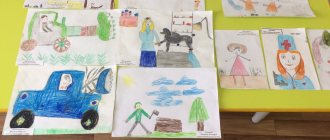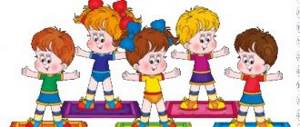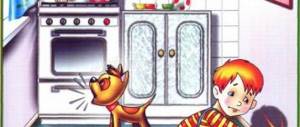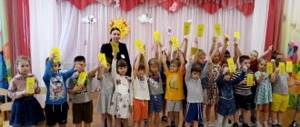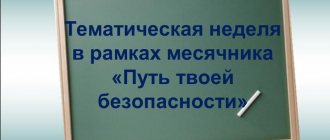Summary of mathematics lessons in the preparatory group
Municipal budgetary educational institution
"Bekhteevskaya secondary school
Korochansky district, Belgorod region"
«Summary of a lesson in mathematics in preparatory group A»
Educator:
Kotlyarova Natalia Alexandrovna
Bekhteevka 2017
Summary of a mathematics lesson in preparatory group A.
Topic: Simple arithmetic numbers, introduction to the number 15. Lesson No. 17 (E.V. Kolesnikova)
Purpose of the lesson:
continue to learn how to write addition and subtraction problems and become familiar with numbers within 20.
Tasks:
• Educational
Improve forward and backward counting skills within 10; continue to develop the ability to understand the relationships between numbers in a number series; consolidate knowledge about geometric shapes, the sequence of days of the week; improve the skill of orientation on a sheet of paper in a square and the ability to navigate in space, spatial representations.
• Developmental
Develop ingenuity, memory, coherent speech.
• Educational
Cultivate friendly relations and neatness.
Materials:
pen, workbooks, colored pencils, pencil.
Progress of the lesson:
1.
Organizing time.
–
Hello guys, today is December 14th. The day of the week is Thursday, and now it’s a math class. We’ll be working in a printed notebook, check if you have everything ready for class.
– open the notebooks with lesson No. 17 and start working.
Task “Listen, count, write down”
(sheet 17, fig. 1)
- Guys, listen to the poem:
Vanya has one game
Sailors have more fun in battle
Blew and floated in the bath
All 15 ships
- How many large ships are there in the picture?
- How can you say it differently?
- How many small boats are there in the picture?
- How many boats are there in the picture?
- How did you get the number 15?
- Write how you got the number 15 and read the entry
Greetings
Checking readiness for class
Children answer questions, complete tasks in the workbook
Development of thinking, ability to answer questions
2.
“We write the number 15”
(sheet 17, Fig. 2)
- Guys, write the number 15 to the end of the line
Children complete the task in the workbook and formulate the task independently
Development of the ability to independently formulate the conditions of the problem
3.
Finger gymnastics “Hat for Lily.”
The girl Lily was given a hat
(connect alternately the fingers of both hands with the thumbs);
On Lily's hat (clap hands)
Ribbon with lily (flower exercise);
A ribbon with a lily is attached to the hat,
(connect alternately the fingers of both hands with the thumbs)
;
The girl Lilia is always in order (they clap their hands, put their thumb forward for the last word, the rest of the fingers are clenched into a fist).
Children perform movements in accordance with the text
Development of the ability to perform movements in accordance with the text
4.
Game exercise “Add and connect correctly”
(sheet 17, Fig. 3)
- What do you need to do in this task?
- Write the digits of the number in the empty squares, name them
- Match the number with the card that matches the number of items
- What number is the card with flowers connected to? Why?
- What number did you connect the card with balls to? Why?
- What number did you connect the card with leaves to? Why?
- What number was the card with beetles connected to? Why?
Children answer the teacher’s questions and complete the task in the notebook.
Formation of the ability to establish correspondence between the number of objects and numbers
5.
“Drawing a cat
(sheet 17, fig. 4)
- Guys, what do you think needs to be done in this task?
- Draw a cat as shown in the picture
- What geometric shape does a cat's tail resemble?
- What geometric shape does a cat's head resemble?
- What geometric shape do a cat's ears resemble?
- What geometric shape do a cat's paws resemble?
Children formulate the task and write down the solution in their workbook
Development of the ability to navigate by cells
6.
Self-monitoring and self-assessment of work performed.
– What did we talk about today?
Children answer the teacher’s questions, analyze what worked and where they had difficulty.
Development of coherent speech, formation of self-control skills
infourok.ru
Long-term plan for mathematical development in the preparatory group
Svetlana Rizhko
Long-term plan for mathematical development in the preparatory group
1
Repetition. Repeat direct counting within 10; consolidate children's knowledge of numbers and the names of geometric shapes; develop attention and logical thinking.
2 Binary code. Mastering the ability to understand binary code and the positive principle of writing numbers. To consolidate children's knowledge about numbers, that the number of objects does not depend on where they are and how to count them: from right to left or from left to right (counting direction)
.
3
Parts of the day.
The concept of "string"
,
“column”
in a notebook.
Learn to find signs of difference between one group of objects and another . Introduce the concept of “line”
,
“column”
. Give the concept that morning, day, evening, night make up a day. Reinforce knowledge about the sequence of parts of the day.
4 Problem solving. Cultivate in children a strong interest in mathematics , teach them to count, and solve problems; consolidate the knowledge that the serial number of an object depends on how to count - from left to right or from right to left; develop ingenuity and hand motor skills.
5
Days of the week.
Consolidate knowledge about the days of the week, remember their names. Give the concept - 7 days are parts of a week. Continue to learn how to navigate on a sheet. Develop logical thinking .
6
Mathematical signs + , -, =, <, >. Learn to find signs of difference between one group of objects and another . Reinforce knowledge about the signs +, -, =. Give a concept - beginning (dot)
report that Monday is not always the first.
7
Property of a triple of adjacent numbers To give the concept that any number is relative - it is both greater and less.
Continue learning to use the signs <, >. Exercise children in ordering sticks by length, mastering the composition of a number, increasing a number by adding 1. Develop the ability to think and reason.
8
"Calculating machine"
Learn to navigate the table.
Continue learning to solve arithmetic problems. Reinforce the concept of “column, row”
.
Develop design skills, create a figure - silhouette, focusing on the sample.
9
Composition of numbers. Continue to teach how to solve arithmetic problems, lay out the solution on a flannelgraph using numbers and signs; continue to introduce the composition of numbers from two smaller ones. Strengthen the ability to navigate on a sheet of paper. Develop logical thinking .
10
Structure of an arithmetic problem. Introduce the structure of an arithmetic problem, introduce the terms condition and question of a problem into speech practice, continue to teach how to solve problems and post a solution. Learn to write questions about a story picture. Reinforce the basic properties of the natural series (increasing numbers, relationships between numbers)
.
Develop fine muscles of the fingers.
eleven
We measure with a ruler. Learn to measure with a ruler. Continue learning to solve a logical problem. Strengthen the ability to solve examples, navigate on a sheet of paper in a cage.
12
Dienesh figures. Develop combinatorial logical thinking, the ability to encode and decode information about properties, visual perception and attention. Strengthen the ability to classify geometric shapes according to 2 - 3 criteria.
13 Compose and solve a problem Learn to compose arithmetic problems, introduce them to its structure, continue to teach how to solve problems. Continue to introduce the composition of numbers from two smaller ones, consolidate the ability to understand the relationship between numbers, the ability to navigate on a sheet of paper in a square.
14 "Calculating machine"
Exercise children in performing arithmetic operations within 10. Continue to introduce the composition of numbers from two smaller ones.
Develop ingenuity and attention.
15 Measuring length Continue teaching children to measure objects using a conventional yardstick. Introduce length units such as step, span, cubit, fathom. Strengthen the ability to navigate on a checkered sheet of paper.
16 Clocks Introduce watches, their variety and purpose, teach how to tell time. Develop logical thinking and fine motor skills.
17 d\i “Attention”
Continue to teach how to solve
a mathematical problem , name its structure, and lay out the solution on a flannelgraph. Continue to introduce the composition of the number 9 from two smaller ones. Practice counting by ear. Reinforce the concept of even and odd numbers. Develop memory , attention, and the ability to navigate on a squared sheet of paper.
18 Cuisenaire sticks Exercise children in quantitative counting, spatial orientation, ordering sticks by length, mastering the composition of numbers, distinguishing numbers, colors; develop the ability to think and reason.
19 A. Zak’s task: Learn to find the differences between one group of objects and another , develop intellectual abilities. Continue learning to tell time using a clock. Practice solving arithmetic examples. Strengthen the ability to form the number 9 from two smaller ones.
20 Puzzle from sticks Exercise children in independently searching for ways to compose figures based on preliminary thinking about the course of the solution. Strengthen the ability to navigate on a sheet of paper.
21 Heavier, lighter.
Comparison by weight. Reinforce the concept of measuring the mass of objects using scales. Practice forward and backward counting. Develop attention and graphic skills.
22 Dienesh Figures Continue the formation of a logical operation, denoted by the conjunction “and”
,classification based on two properties.
Learn to transform shapes according to the algorithm. Develop design abilities.
23 Roman numerals Introduce children to Roman numerals, practice laying out Roman numerals from sticks. Continue learning to compose and solve arithmetic problems; make the number 10 from two smaller ones. Practice counting forward and backward within 10 (20)
. Strengthen the ability to understand the relationships between numbers.
24 Challenges for ingenuity
Learn to solve problems with ingenuity, develop logical thinking . Strengthen the ability to form the number 10 from two smaller ones, orientate yourself on a sheet of paper in a cage. Strengthen your knowledge of Roman numerals. Develop memory and attention .
25 Payment for goods with coins. Introduce payment for goods using coins of different denominations. Practice solving arithmetic problems, adding and subtracting numbers. Develop logical thinking .
26 Counting in tens up to 100. Introduce a new counting unit - ten. Learn to count by tens up to 100. Practice adding and subtracting numbers. Strengthen your knowledge of geometric shapes. Develop logical thinking and graphic skills.
27 Math fun
"Treasure Hunt"
Continue learning to solve arithmetic and logical problems, practice counting backwards, and consolidate knowledge of numbers within 10;
navigate using a plan map and a checkered sheet of paper . Strengthen the ability to compare and classify geometric shapes by color, shape, size. Develop design abilities.
28 Drawing by squares Learn to navigate by squares, follow the instructions of an adult at the same time as other children. Strengthen your knowledge of Roman numerals. Develop logical thinking . Practice adding and subtracting numbers.
29 Number 11 Introduce the formation of the number 11, fix the counting unit - ten; the ability to establish correspondence between number and figure. Learn to tell time accurate to half an hour, draw an object from geometric shapes. Practice counting forward and backward by tens within 100
.
30 Interesting task A. Zak “Difference”
Develop the ability to analyze - master the solution of “Difference”
related to the search for one drawing by A. Zak. Continue to learn how to solve arithmetic problems, lay out the solution on a flannelgraph, and complete the given algorithm in a notebook. Strengthen the ability to use the signs <, >, =.
31 Number 12. Learn to solve puzzles using sticks. Introduce the formation of the number 12, understand the relationships between numbers within 10. Consolidate knowledge about geometric shapes, learn to sketch them in a notebook.
32 Journey through the fairy tale “The Snow Queen”
(using illustrations for the fairy tale)
Strengthen quantitative counting forward and backward up to 10; continue to teach how to distinguish figures based on several characteristics, group and classify , and use algorithms of actions based on verbal and graphic indicators. Develop visual-figurative thinking and the beginnings of logical, auditory and visual attention, cognitive interest. Develop the ability to work in a team, respect the opinions of comrades, and give in to other guys.
33 All year round Learn to find differences between one group of objects and another . Teach counting backwards by tens within 100. Continue to teach how to navigate on a sheet of squared paper. Fix the seasons, all the months of the year.
34 Number 13 Introduce the formation of the number 13 and the new counting unit - ten. Learn to measure and draw segments of a given length. Continue to teach how to solve an arithmetic problem, lay out the conditions of the problem, read the recording. Continue to teach how to solve a logical problem to establish patterns. Strengthen the ability to form numbers 5, 6, 7 from two
smaller ones.
35 Clocks Learn to tell time to the nearest half hour. Continue to learn how to compose and solve an arithmetic problem, write down the solution to a problem using numbers and signs. Develop the ability to understand a learning task and complete it independently.
36 Inverse problems. Introduce children to solving inverse arithmetic problems. Continue to introduce the formation of two-digit numbers - numbers 13. Strengthen spatial concepts: inside - outside, left - right, on - under - behind, use them in speech.
Develop memory , attention, graphic skills.
37 d\ and "Tangram"
Continue learning how to modify shapes using an algorithm. Strengthen the ability to solve examples. Reinforce your knowledge of geometric shapes. To train children in the ability to compose new geometric shapes according to the model.
38 Number 14 Introduce the formation of the number 14 and the new counting unit - ten. Continue learning to solve inverse arithmetic problems; navigate on a sheet of paper in a cage. Reinforce your knowledge of the days of the week.
39 Racing. Learn to solve a logic problem involving negation. Continue to introduce the formation of the number 14. Practice solving examples. Develop the ability to understand a learning task and complete it independently.
40 Logic problem
"How many triangles"
Learn to solve entertaining and logical problems . Continue to learn how to navigate time periods. Reinforce knowledge about geometric shapes - polygons. Develop attention and the ability to complete a learning task independently.
41 Division into parts. Learn to divide a whole into parts. Continue learning to form the number 8 from two smaller ones. Fix forward and backward counting within 14. Develop memory and graphic skills.
42 Number 15 Introduce the formation of the number 15. Continue teaching how to establish a correspondence between the number of objects and the number. Learn to draw a symbolic image of a cat, name the geometric shapes of which it consists. Develop logical thinking .
43 More - less Learn to balance weight using a kettlebell. Continue learning to solve arithmetic and inverse problems; use the signs ", ". Strengthen your knowledge of numbers and complete the learning task independently.
44 Treasure Island Contribute to the manifestation of children’s mental activity and their logical and mathematical development . Continue to learn the composition of a number from two smaller ones, spatial relationships. Develop attention , memory, and the ability to finish what you start.
45 Area of figures Form an idea of the area of figures, directly comparing figures by area. Continue learning to find the differences between one group of figures and another . Develop logical thinking .
46 Area of figures Give children the concept that the area of a figure does not depend on the relative position of the parts. Continue to introduce the formation of the number 15. Practice solving examples within 10.
Develop graphic skills.
47 Intelligence problems Learn to solve intelligence problems. Continue to learn how to tell time using a clock; navigate on a sheet of paper in a cage. Fix the composition of the number 9 from two smaller ones. Develop memory and attention.
48 Come up with a problem Continue to teach how to create an arithmetic problem, lay it out on a flannelgraph and read the solution to the problem. Learn to solve a logical problem involving a missing figure. Develop attention , memory, graphic skills.
49 Stick puzzle Learn to solve problems involving constructing a square from a certain number of sticks and transforming it by adding sticks. Continue to teach memorization and comprehension of the task. Practice solving examples. Develop thinking and attention.
50 Number 16 Introduce the formation of the number 16. Continue learning to compose arithmetic problems for addition and subtraction, and solve them. Develop the ability to navigate on a sheet.
51 We measure the area with a conventional measure Continue learning to measure the area with a conventional measure - a square. Continue learning to form the number 10 from two smaller numbers. Strengthen the ability to divide figures into groups according to different criteria .
52 Measuring volume Form ideas about volume (capacity, comparing vessels by volume using transfusion. Continue learning to solve an arithmetic problem, fix the structure of the problem, lay out the solution on a flannelgraph. Learn to draw a picture by dots, navigate in a squared notebook.
53 Point, lines. Acquaintance with different types of lines: straight, wavy, broken, closed, open. Introduce the rule that many lines can be drawn through one point, but only one line can be drawn through two points. Strengthen the ability to use a ruler.
54 Entertaining task A. Zaka "Rooster"
Learn to solve
entertaining problems , develop ingenuity ; “Rooster”
problems associated with finding the final cell after one movement
(step straight)
.
Introduce children to the concept of “segment”
. Practice counting forward and backward within 20. Strengthen the ability to use a ruler.
55 Number17
"Computer 2"
Introduce the formation of the number 17. Teach children to count claps by ear.
Exercise children in performing arithmetic operations within 10, in comparing numbers; creating prerequisites for mastering the ideas of computer science: algorithm, flow chart, computer. Develop logical thinking , attention, understand the educational task, and carry it out.
56 Game “Journey to Planet Geo ”
Continue learning to solve logic problems and stick puzzles.
Strengthen the ability to distinguish arithmetic problems from riddles, tongue twisters and solve them. Consolidate knowledge of the composition of the number 9. Practice counting forward and backward within 20; identify and find geometric shapes based on three characteristics (shape, color, size)
. We continue to learn how to navigate on a sheet.
56 "Miracle - Basket"
Number 17 Learn to solve logical problems to find signs of differences between one group and another through visual and mental analysis. Continue learning to compare shapes by area. Reinforce the formation of the number 17; composition of the number 10 from two smaller ones.
57 Volumetric figures. To develop the ability to find objects in the shape of a cube, ball, pyramid, cone, cylinder in the environment. Continue to learn how to navigate on a sheet. Exercise children in performing arithmetic operations and comparing numbers.
58 Seasons. Continue to teach how to compose an arithmetic problem based on a picture and solve it. To consolidate knowledge about the main signs of different seasons; about their sequence. Strengthen the ability to navigate on a sheet of paper in a square. Develop logical thinking .
59 Entertaining task A. Zaka "Wolf"
.
Number 18. Master solving “Wolf”
related to finding the final cell after one movement
(jump)
of the wolf.
Introduce the formation of the number 18. Develop attention , intelligence, and ingenuity.
60 Hours.
d\i "Tangram"
Teach children to make a whole silhouette of an object from parts.
Continue introducing children to watches. Reinforce your knowledge of the composition of the first ten numbers. Develop logical thinking and attention.
61 Gaming
"News from Prostokvashino"
Mastering practical methods of dividing a set into equal parts
(based on a model)
and a circle into 3 equal parts; compiling a given volume of liquid from several smaller ones; determination of time intervals by hour; drawing up symmetrical drawings; establishing a correspondence between the distance and the amount of liquid required to overcome it.
62 Fun challenges. Teach children to solve mathematical problems , lay out the solution on a flannelgraph. Learn to analyze a pattern, draw it according to a model. Continue to introduce the formation of the number 18. Strengthen the ability to measure distance using a conventional measure - steps, and compare the results obtained.
63 Cuisenaire sticks Exercise children in quantitative and ordinal counting, spatial orientation, and ordering sticks by length. Develop the ability to think , reason, prove, independently formulate questions and answer them.
64 School of the Scientific Pencil. Learn to solve arithmetic problems. Introduce the formation of the number 19. Continue teaching to understand the learning task and complete it independently.
65 Entertaining task A. Zaka "Fox"
To promote mastery of solving
Fox
.
Reinforce your knowledge of the composition of the first ten numbers. Develop logical thinking , attention, graphic skills.
66 Games. ex. "Where is whose house"
Introduce the formation of the number 19. Continue to teach children to solve logical problems to find a sign of the difference between one
group of figures and another , learn to solve examples within the second ten, and navigate on a sheet of paper in a square. Develop attention .
67 Number 20.
Labyrinth. Introduce the formation of the number 20. Continue to teach how to compose an arithmetic problem, name the structure of the problem; learn to solve a logical problem. Reinforce knowledge of the parts of the day; Roman numerals, find a pair for them. Develop attention and graphic skills.
68 Two-digit numbers. Continue to introduce children to the formation of two-digit numbers. Practice counting forward and backward to 100 in tens. Develop ingenuity and intelligence by solving entertaining problems ; graphic skills.
69 Two-digit numbers. Learn to form two-digit numbers. Continue learning to solve a logic problem to find missing figures. Practice counting forward and backward within 20. Continue to develop arithmetic and graphic skills.
70 Game
"Island of Wonders"
Summarize the knowledge acquired during the year: Continue to teach children to compose arithmetic problems and write down their solutions using numbers.
Fix the name of the geometric shapes. Reinforce knowledge about the composition of the number 8 from two smaller numbers. Reinforce knowledge about the sequence of days of the week. Practice time orientation, consolidating knowledge of telling time by clock. Strengthen the ability to navigate on a sheet of paper in a square. Develop ingenuity , visual memory, imagination.
Contribute to the formation of mental operations, the ability to give reasons for one’s statements. 71 Figures of Dienesh Continue to teach children to find and name three-dimensional shapes: ball, cube, cone, cylinder, pyramid. Develop logical thinking , the ability to encode and decode information about the properties of geometric shapes. Practice solving arithmetic operations.
72 Gaming
"The Thirtieth Kingdom"
Develop computing skills;
continue to learn how to solve addition and subtraction problems; develop attention and observation; continue to teach children to decode information encrypted on code cards /color, size, shape/; instill an interest in solving entertaining problems with a mathematical meaning ; continue to learn how to navigate on a plane; activate children's vocabulary; learn to find the ninth missing image through visual-mental analysis, correlating the horizontal and vertical positions of objects.
Kolesnikova E.V. Mathematics for children 6 - 7 years old. Methodological manual for the workbook [PDF]
Tasks for parents of preschoolers to consolidate material on lexical topics: “Berry”, “Days of the week. Parts of the day”, “Summer”, “Transport”, “Birds”, “Dishes”, “Late autumn”, “Clothing (winter), shoes, hats”, “New Year”, “Wintering birds”, “Migratory birds” ", "Winter", "Animals of hot countries", "Trees", "Wild animals", "Mom's holiday. Women's professions", "Mushrooms",...
- 517.68 KB
- date added unknown
- modified 03/23/2017 01:44
2nd ed., add. and processed - M.: TC Sfera, 2005. - 80 p. — ISBN 5-89144-211-6. The third part of the series “Mathematical steps” (from work experience) is intended for working with children 5-6 years old (older group). It includes a methodological guide for conducting 32 educational and game activities and a notebook “I count to 10” for the child to complete tasks. Recommended to a wide range of specialists…
- 98.02 KB
- date added unknown
- modified 02/11/2019 18:38
Workbook for children 6-7 years old. — M.: Sphere shopping center. 2007. - 64 p. The notebook is an appendix to the fourth part of the series “Mathematical Steps” (from work experience) and is intended for working with children 6-7 years old. Through a system of exciting games and exercises, children will get acquainted with numbers up to 20, expand their knowledge about the seasons and parts of the day, about geometric shapes, learn...
- 144.83 MB
- added 11/24/2011 6:53 pm
- modified 27.11.2011 21:02
2nd edition, revised and expanded. - M.: TC Sfera, 2011. - 64 p. The notebook is an appendix to the third part of the “Mathematical steps” series (from work experience) and is intended for working with children 5-6 years old. Through a system of exciting games and exercises, children will get acquainted with numbers and figures up to 10, expand their knowledge about the seasons and parts of the day, about geometric...
- 869.11 KB
- added 10/11/2012 00:11
- modified 10/11/2012 20:39
M.: TC Sfera, 2009. - 64 p. - (Mathematical steps). — ISBN 978-5-9949-0514-2. Notebook on the formation of elementary mathematical concepts - final hour
www.twirpx.com
